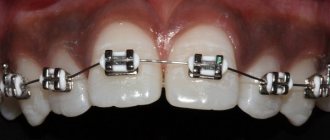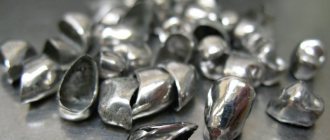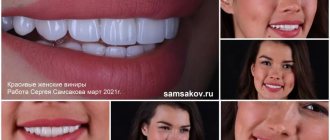Malocclusion is a common pathology that is diagnosed in both childhood and adulthood. Bite correction is a long, complex process, as a result of which the patient receives a healthy and beautiful smile. It is a mistake to believe that malocclusion is solely a problem of appearance, since it generally has a detrimental effect on the condition of the dental system. Malocclusion is associated with dysfunction of the temporomandibular joints, inflammatory gum diseases, and an increased risk of dental caries due to difficulties in hygienic care.
The most popular method of combating malocclusion in modern dentistry is to install braces on the patient. There are several main types of braces on the market, each of which is effective for correcting malocclusion, but has its own nuances of use. Of the budget options, dentists most often recommend metal or ceramic braces. In this regard, many are interested in which braces are better, ceramic or metal. Both options cope well with their main function - bite correction, however, there are some nuances in wear and appearance that must be taken into account when choosing.
Content:
- Features of metal braces 1.1. Pros and cons of metal devices
- Features of ceramics 2.1. The most modern ceramic devices for correcting bites
- What are the similarities between both types of braces?
- Main differences between metal and ceramics
- Is there a compromise?
Today, orthodontists have many modifications of brace systems in their arsenal, differing in a number of parameters.
Since most patients want to correct their bite while maintaining an attractive appearance of their smile, the material from which it is made comes to the fore when selecting an alignment structure. According to statistics, most often clients of dental clinics choose ceramic or metal braces. Let's try to figure out why these devices are in high demand and which ones are better.
Frequency of visits to the orthodontist while wearing braces
The same advertisement assures – choose expensive non-ligature braces and you won’t have to constantly go to the dentist. But in reality, the situation is exactly the opposite: self-ligating structures do not allow you to simply change the type of fastening of the arch base, and therefore the doctor will need to change the arch itself.
You can also hear that non-ligature braces are safer for patients, since the pressure they create is less than that of ligature systems. But this is an exaggeration: there is practically no difference in the degree of load between the types of structures under consideration, and these data are confirmed by a number of studies.
Based on the information presented, we can draw a simple conclusion - ligature-free braces are by no means the best option for the system. Yes, they are somewhat easier to care for, but the treatment process using this type of braces is more complex, specific, and, taking into account the price of self-ligating braces, more expensive for patients.
Features of metal braces
Metal devices are rightfully recognized as the most reliable and durable. They have a budget price that doesn’t hit the consumer’s wallet so hard, and they do an excellent job of their functions. But there is one “but” - they don’t look attractive at all.
To improve their appearance, developers began to use alloys with a special Teflon coating in the production process. The latter gives the device a light tint, making its elements less noticeable to others.
Metal devices can be:
- ligature;
- self-regulating.
The first ones are presented in a rich range of colors, so teenagers love to experiment with them. When wearing them, you need to visit the orthodontist approximately once every 1-3 months. The duration of bite correction takes up to two and a half years.
Self-adjusting devices are smaller than ligature ones, but their locks are thicker. They are easier to care for. They usually cost more.
Pros and cons of metal devices
A person studying the features of ceramic and metal braces is usually interested in the advantages and disadvantages of these types of systems.
In this case, the advantages include:
- very reliable fixation;
- resistance to all types of food dyes (do not stain);
- the ability to quickly correct existing crooked teeth;
- low risk of breakdowns;
- smooth surface, pleasant to the touch;
- decent hygienic characteristics;
- reasonable cost.
The disadvantages of metal devices are:
- not very beautiful appearance, due to which the patient may experience psychological discomfort;
- may cause allergies if a person has individual intolerance to metals.
Final tables comparing types of structures
To understand which braces are best to install for defects in the dental system, we suggest that you familiarize yourself with the summary information presented below:
| Sign | Vestibular braces | Lingual braces |
| Efficacy of therapy | High | Sometimes it works more effectively, in other clinical cases it does not have a sufficient effect |
| Duration of treatment, years | 1,5-2 | 2-3 |
| Design reliability | Excellent durability | Sensitivity to external influences |
| Popularity | Very popular | Installed less frequently due to unattractive cost |
| Aesthetic component | Low or medium | Invisible to others even with a wide smile |
| Difficulty of fixation | Not difficult | Quite difficult to attach |
| Hygienic care | Standard Procedures | Very difficult to care for |
| Adaptation period | Just a few weeks | Long, up to 3 months or more, sometimes patients never get used to the accessory |
| Wearing comfort | Doesn't cause discomfort | Inconvenient |
| Presence of pain | Minor soreness | Hurt |
Comparative analysis of accessories made from various materials:
| Characteristic | Metal braces | Ceramic systems | ||
| Classic | Self-ligating | Classic | Self-ligating | |
| Visibility | Visible due to contrast with enamel | Hidden | Barely distinguishable | Hidden behind teeth |
| Cost, thousand rubles* | from 80 000 | from 110 000 | ||
| Result in severe cases | Highly effective for seemingly hopeless deformities | Effective for most problems | Coping with advanced pathologies | |
| Convenience | Affects soft tissues | Injures the mucous membranes and tongue, causing diction problems | Rub during the first week of wearing | After the adaptation period, wounds can be avoided if you are careful |
| Hygiene | Difficult to clean | Cleans quickly, but is fragile and requires careful handling | ||
| Main disadvantage | Noticeable when communicating | Expensive | ||
*To get accurate prices for different types of turnkey correction, go to the Dentics website, or better yet, make an appointment and find out from the orthodontist personally which option is right for you.
Features of ceramics
Ceramic devices were created specifically for patients who are accustomed to having a perfect smile. In color they almost completely match the enamel, so they are hardly noticeable to others.
Like metal analogues, they come in:
- ligature - fixed on the front surface of the dentition;
- non-ligature - adjustable using special clips.
Among the undeniable advantages of ceramics, orthodontists name:
- excellent hygiene;
- good aesthetics;
- absence of bulky locks;
- sufficient strength.
They do not provoke allergies, and therefore are an ideal solution for allergy sufferers.
At the same time, they are less durable than metal ones, and break more often; they can be painted with food coloring. They are larger in size than metal ones. They cost more.
The most modern ceramic devices for correcting bites
Damon Clear ceramics are in high demand among patients today. Its distinctive feature is one hundred percent resistance to pigmentation. Reflection devices from Ortho Technology have also proven themselves well. They are made from special aluminum oxide polycrystals and do not leave stains on tooth enamel or cause discoloration.
The Mistique GAS designs are considered a worthy option. They are coated with silicon oxide, and therefore also do not absorb coloring particles and maintain the natural color of the enamel.
Combined systems
There are also systems more complex in design and functionality used in dentistry. We are talking about hybrid or combined orthodontic brackets, for example:
- lingual-vestibular;
- metal-ceramic;
- metal-sapphire;
- ligature-self-regulating, etc.
There can be many such combinations. Braces systems are constantly being modernized and becoming more and more functional. Hybrid designs can combine aesthetics, versatility, reliability, strength, etc. But they require large financial investments from the patient and high professionalism from the dentist.
It is worth remembering that the effectiveness of treatment is determined not only by the type of structure. Much depends on how a person cares for his teeth and braces. To keep them intact and prevent the development of caries, you must adhere to a number of recommendations:
- stop smoking and alcohol;
- buy a special brush and brush for berkets;
- use dental floss and irrigators;
- limit your consumption of sweets;
- give up solid foods;
- Avoid sticky foods and drinks with dyes.
When purchasing toothpastes, mouthwashes and other hygiene products, choose products that are recommended for orthodontic treatment.
What are the similarities between both types of braces?
Both devices cope perfectly with their main function - eliminating even severe tooth curvature. Both metal and ceramics cannot be installed if:
- untreated caries;
- the presence of deep cracks on the enamel surface;
- the presence of implants, crowns, bridges;
- oncology.
Both systems cause discomfort during the adaptation period. After each successive tension of the arch, a person experiences pain for several days.
Main differences between metal and ceramics
If we compare the described products with each other, then we need to focus on four main factors:
- Reliability. According to this criterion, metal devices win.
They can easily withstand any mechanical stress, so they remain intact throughout the entire treatment period. Ceramics is inferior in strength, but when used correctly (if the patient strictly follows all medical recommendations) it also wears quite well. However, it is not recommended for professional athletes to install it. - Appearance. Ceramic braces are unnoticeable. They almost match the natural color of the teeth, so they are suitable for people who lead a public lifestyle and speak in public. Metal does not look as aesthetically pleasing and creates a pronounced contrast on the dentition. However, if you plan to use it, you can ask the orthodontist to use arches that are fixed on the inner surface of the teeth. But they are so expensive.
- Price. Ceramic devices are inferior here - they are more expensive, so not every patient in a dental clinic can afford such treatment. Metal has a more reasonable price. This is its main advantage.
- Convenience. According to user reviews, ceramics cause slightly less discomfort. Therefore, if a person has a low pain threshold, he should give preference to braces made of this material.
In any case, the final decision must be made together with your doctor. After all, the main goal of orthodontic therapy is to give certain teeth the correct position. And the emphasis in this situation should no longer be on beauty, but on functionality and a guarantee of obtaining the expected result in the shortest possible time.
Correct bite: 100% beautiful smile
Occlusion is the interaction of the upper and lower dentition when the jaw is closed. Disturbances in the formation of bite lead to accelerated wear of the tooth enamel of the incisors, canines and molars. Orthodontists will help create a beautiful smile and improve a person’s psychological state.
If you have problems with your teeth, please contact our clinic. We use modern technologies to gradually change the position of teeth and give them the best position.
Please note: According to statistics from the international health organization, about 80% of residents of developed countries have an incorrect bite. Sometimes such problems are cosmetic in nature, but there are also serious deviations that require the intervention of specialists.
Is there a compromise?
For clients who can’t decide whether to choose ceramic or metal braces, dentists today can offer a compromise option. Its essence is to install ceramic devices on the teeth located in the smile zone, and metal ones on all others.
This combination allows you to make the cost of orthodontic treatment more affordable, preserve the aesthetics of your smile and obtain excellent therapeutic results.
Remember: braces are just a tool in the hands of a doctor. An experienced doctor knows how to eliminate a patient’s defect using different types of devices. But he offers exactly those that will make your smile more attractive more quickly and less traumaticly. Therefore, trust your doctor and strictly follow all his instructions. By following this rule, you will correct your bite very quickly.











